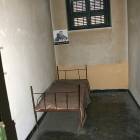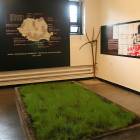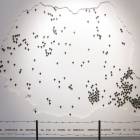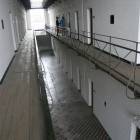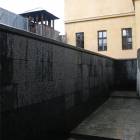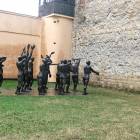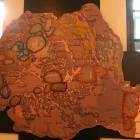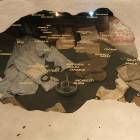Sighet Memorial for victims of communist terror
It is one of those places you have to see to better understand history. During communism, in Romania there were functioning 44 political prisons and 72 forced labor camps. They were the place of torture and often death for something like 1 out of 10 Romanians in the first two decades after the second world war.
Estimating the number of victims by communism in Romania is a difficult task, because the regime had in total 45 years at its disposal to cover its traces. The Institute for Investigating Communist Crimes estimates at 3 million people the number of political detainees in communist Romania. Of which, 800.000 people died in detention or shortly after. Another estimate comes from the Presidential Committee of Control, led by Vladimir Tismăneanu, a former communist and son of the head of communist Propaganda, who gives a milder estimate of 2.000.000 people affected by persecutions (including family members) and 600.000 sentenced political prisoners.
Communism was established in Romania as an outside occupation force, as consequence of losing the second world war. Before the moment when the country was occupied by Soviet Union’s Red Army, the population was among the most hostile to communist ideas on the continent. This attitude had several reasons. Communism was atheistic, while Romanians were devout Orthodox Christians. Communism was internationalist, while Romanians had just managed to unite their historic provinces in a single country after the first world war. From this perspective alone, communists were viewed as traitors to the nation. Communism spoke about industrial proletariat, but the country was hardly industrialized back then. Communism proposed common state farms, while Romanian peasantry was formed of millions of small land owners who didn’t want to hear about giving up private property.
This social landscape lead to Communist Party having less than a thousand members in the country before Soviet occupation. Most of that modest membership was formed by Jews and other minorities in the country. When Russians entered the country and king Michael switched sides joining the allied forces, many Romanians headed to the mountains. It was the longest armed resistance against communism on the continent, spanning for over 15 years. The rebels hoped for an American intervention, helping them to liberate the country. Little did they know about the secret agreements at Yalta between Stalin, Roosevelt and Churchill, being deceived by the American aid dropped to them from airplanes from time to time.
The people who remained in cities and villages were faced with the most brutal repression carried out in Europe outside of Soviet Union. The large prison system was organized by categories of prisoners in some key spots. The largest part of prisoners were ironically formed by peasants who opposed collectivizing agriculture (giving up property of their farm). We say ironically, because the hammer and the sickle were supposed to symbolize the union between proletariat (factory workers) and peasants. So the latter were not supposed to be the main enemy of a socialist regime. A large number of them were used to dig a canal connecting Danube to the Black See.
Another targeted category were priests, mystics and sympathizers of the Legionary Movement, who were imprisoned in centers like Aiud or Gherla. There were also prisons dedicated to women. For the youngest, it was considered that extermination through exhausting work, starvation and beating was not viable. So a so called “reeducation” was tried out for a few years. The epicenter of such a horrific scheme was the prison in Pitești, where former students were subjected to a brainwashing attempt through extreme forms of violence, humiliation and psychological torture.
Sighetu Marmației is in the north of the country, close to the current border with Ukraine (back then, with USSR). At Sighet, the prison was dedicated to the elite of political class. It was a surreal setting to see there reunited prime ministers, ministers, parliamentarians or army generals, admirals, all dressed in prison uniform and emaciated from famine and tortures.
Sighet was one of the smallest prisons, with just 200 prisoners, of which a quarter perished during imprisonment in less than a decade. Among them, four Greek Catholic bishops, several members of former governments. The most preeminent is Iuliu Maniu, former prime minister and leader of Conservative Party, whose cell is specially organized in the current memorial. Also brothers Dinu and Gheorghe Brătianu, an important historian, author of „Romanian people, an enigma and a miracle”, coming from the most important political dynasty of the National Liberal Party. We find on the list former minister Constantin Argetoianu, economist and former governor of National Bank Mihail Manoilescu.
Political prisoners from Sighet were transfered to other penitentiaries in 1955. Eventually, in 1964 a large pardon was given to survivors, but that was already 20 years after the beginning of the regime.
After the anti-communist revolution of 1989, Sighet was turned into a public Memorial by the efforts of poet Ana Blandiana and her husband, writer Romulus Rusan. They formed an NGO, Civic Academy, that united 175 public personalities, including journalist Lucia Hossu Longin, author of a vast project of video interviews with survivors of persecutions. Mihai Cârciog, a businessman residing in London, was the most important sponsor of the project in its initial phase.
Photographs, garments, manuscripts and other objects were gathered to form a museum of victims of communism. Numerous sculptors contributed with artistic creations that are displayed in the former cells. The most popular is that of Camilian Demetrescu. It represents a cortege of detainees walking towards the wall.
Prison’s yard is arranged as a place of recollection and reflection. It was here where prisoners had the short privilege of enjoying the clear sky, as the windows of the cells were largely blocked and one punishment included isolation in humid cold cells with no windows at all. A tunnel takes the visitor to an underground sacred room that is symbolizing a Christian catacomb from the time of pagan Rome persecutions. The walls of black marble are carved with the names of 8.000 Romanians killed during communism, collected from documents in a meticulous effort of about a decade.
Mai multe despre: Romania • anticommunism • communism • memorial • prison • Romania • Sighet • totalitarianism- Home Page
start page - Architecture
landmark buildings - Sacred architecture
places of worship - Nature
landscape photography - Concert
performing artists - Christmas
Santa Claus pictures
- Jooble
jobs for photographers - Escape
an out of control blog - Merry Christmas
The best organizer of Christmas parties - Astro photo
Eclipse hunting and astrological photography


